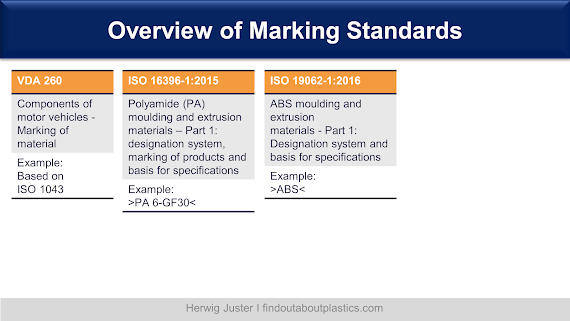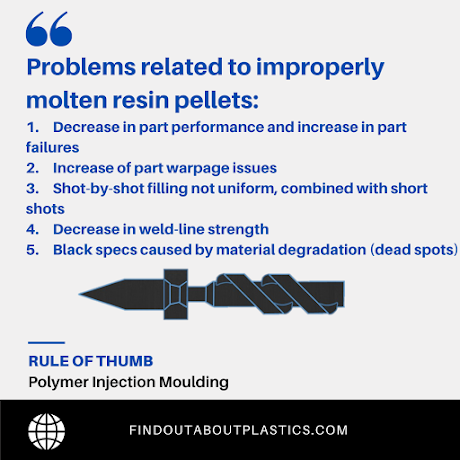Hello and welcome to a new post. In this blog post we have a closer look at the plastic part marking standards and their differences.
I made a short presentation about this topic which you can watch here:
Why Part Marking Codes?
Identification of plastics products is easier with a part
marking system. This allows for better decision making for:
- handling plastic products,
- better waste recovery
- more efficient disposal.
Overview of Marking Standards
There are three main standards; however there are additional
ones for each of the polymers.
ISO 11469:2016: Generic identification and marking of
plastics products
Example: acrylonitrile-butadiene-styrene polymer “>ABS<”
ASTM D7611: Resin Identification Codes (RICs) consisting
out of a equilateral triangle, Resin Identification Number, and abbreviated term
for polymeric material.
Example:
ISO 1043, ISO 1629 (rubber), ISO 18064 (TPE): Plastics –
Symbols and abbreviated terms:
Part 1:
Basic polymers and their special characteristics
Part 2:
Fillers and reinforcing materials
 |
| ISO 1043 - Part 2: Fillers and reinforcing materials (material) |
 |
| ISO 1043 - Part 2: Fillers and reinforcing materials (form) |
Part 3:
Plasticizers
 |
| ISO 1043 - Part 3: Plasticizers |
Part 4: Flame Retardants
The tables below show an overview of the most common flame retardant classes, as well as the detailed codes. We can distinguish between halogen compounds, nitrogen compounds, halogen-free organophosphorus compounds,inorganic phosphorus compounds, metal oxides, Boron and zinc compounds, silicon compounds, and graphite.
 |
| ISO 1043- Part 4: overview of the most common flame retardant classes |
 |
| ISO 1043 - Part 4: Flame retardant codes |
Example:
Another part marking standard is the ISO 16396 which was introduced particularly for Polyamides used in injection moulding and extrusion (PA 6, PA 66, PA 69, PA 610, PA 612, PA 11, PA 12, PA MXD6, PA 46, PA 1212, PA 4T, PA 6T and PA 9T and copolyamides of various compositions for moulding and extrusion).
The designation consists out of five data blocks:
-Data block 1: identification of the plastic by its abbreviated term (PA), and information about the chemical structure and composition
-Data block 2: position 1: Intended application and/or method of processing; positions 2 to 8: Important properties, additives and supplementary information
-Data block 3: designatory properties
-Data block 4: fillers or reinforcing materials and their nominal content
-Data block 5: contains additional information which may be added if needed
Example: PA6T/66 MH, 14-190, GF50
PA6T/66: Polyamide 6T which is a homopolymer based on terephthalic acid and Polyamide 66 which is based on hexamethylenediamine and adipic acid.
M: injection moulding; H: heat ageing stabilized
14-190: viscosity number (in ml/g) > 130 but below 150; 190: tensile modulus of elasticity between 17000 MPa and 20000 MPa
Summary of standards:
Miniguide "Plastic part marking"
Supporting this topic, I made a miniguide which can be downloaded below.
Check out my post on flame retardant classifications according DIN EN ISO 1043-4 here.
Thanks for reading and #findoutaboutplastics
Herwig Juster
Interested to talk with me about your polymer material selection, sustainability, and part design needs - here you can contact me
Interested in my monthly blog posts – then subscribe here and receive my high performance polymers knowledge matrix.
Literature:


















